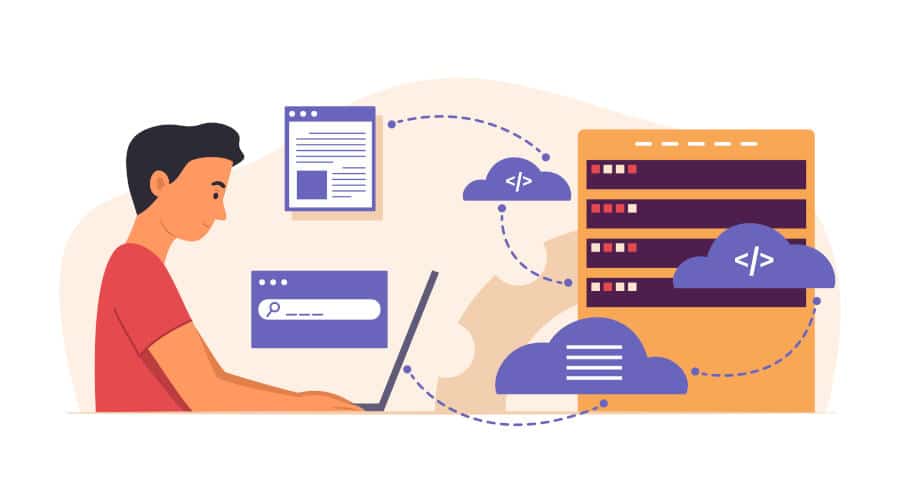An IaaS, or Infrastructure as a Service, enables you to operate computing resources remotely via the Cloud. Find out all you need to know about this revolutionary technology, and its usefulness in Data Science.
Data Science offers a myriad of opportunities for businesses, not least in understanding trends and making data-driven strategic decisions.
However, this complex discipline is technically demanding. It requires an IT infrastructure that is both robust and scalable, capable of handling the intensive calculations and data processing involved.
This is why many Data Scientists and other professionals in this field are turning to Cloud Computing to exploit one of the main categories of services offered by providers such as AWS, Azure and GCP: IaaS or Infrastructure as a Service.
What is IaaS?
This is a Cloud Computing model enabling companies to access IT resources on demand, without having to invest in the purchase and management of physical infrastructures.
This infrastructure-as-a-service brings together a set of virtualized resources such as servers, storage and networks, which can be provisioned and managed via the Internet.
This approach greatly enhances the agility of businesses, enabling them to scale up or down their resources as and when required. And all without having to worry about hardware maintenance!
The technology at the heart of IaaS is virtualization. This involves creating virtual instances of servers, virtual machines and other resources. These can be rapidly deployed and configured according to specific project requirements.
For example, a data scientist can create a virtual machine with the specifications needed to run computationally intensive tasks.
The main IaaS providers are Cloud Computing market leaders such as Amazon Web Services, Microsoft Azure and Google Cloud Platform.
All offer a wide range of IaaS services covering a spectrum of functionalities, from storage to data processing to networking.
So how do you choose the right provider? It all depends on the company’s specific needs and its preference for certain functionalities or integrations. Let’s take a look at how IaaS meets the unique needs of Data Science.

IaaS and Data Science: virtual power for data analysis
Data science projects often face complex computational and storage challenges.
Machine Learning model training requires massive volumes of data to create accurate predictive models.
This process can be extremely computationally intensive, requiring repeated iterations on large amounts of data.
This can be difficult to manage on local infrastructures, but IaaS offers the possibility of provisioning powerful resources to accelerate these tasks.
Compute instances can be optimized to rapidly run complex Deep Learning calculations and other cutting-edge techniques.
Similarly, Big Data analytics can rapidly outstrip the capabilities of traditional infrastructures for processing massive data. Here again, IaaS comes in handy by enabling scalable compute clusters to be created.
In this way, workloads can be distributed across several virtual machines to speed up analysis. On distributed compute clusters, each virtual node manages a part of the workload.
This also avoids processing bottlenecks. This is a valuable asset for data science teams.
Like other fields, such as medical research or engineering, data science can also rely on simulations and experiments to predict complex results.
This task requires considerable computing resources, but IaaS meets this need. During the prototyping and experimentation phase, data scientists can rapidly create virtual environments to test new ideas and maximize their creativity without being hindered.
💡Related articles:
A major advantage for Big Data analysis
An Infrastructure as a Service thus brings several advantages to data scientists. It increases flexibility, enabling resources to be quickly adjusted to meet changing project requirements in terms of computing and storage.
This enables optimum efficiency to be maintained without overload. Likewise, it enables seamless and straightforward scalability to handle growing workloads.
This is an essential capability for projects requiring the rapid processing of large quantities of data or the execution of intensive calculations, such as the search for complex patterns in massive datasets.
What’s more, IaaS can help reduce the cost of data science. The pay-per-use model allows companies to pay only for the resources they actually consume, eliminating the need to invest in oversized infrastructures to anticipate peaks in demand.

Among the companies that have successfully adopted the cloud for their Data Science projects is Netflix. Thanks to this technology, the streaming giant has been able to rapidly analyze the viewing habits and preferences of its users in order to optimize its content recommendations.
Similarly, AirBnB uses IaaS to manage user data and personalize accommodation recommendations. The scalability of this virtual infrastructure enables it to process huge quantities of data in a very short space of time to better understand travelers’ expectations.
These two examples clearly demonstrate the usefulness of IaaS for data science, and illustrate how companies that exploit this asset to good effect can outperform the competition.
Conclusion: IaaS, a scalable and flexible virtual infrastructure ideal for Data Science
The cornerstone of Cloud Computing, IaaS has revolutionized the way companies approach IT infrastructure. Little by little, this technology has established itself as the new standard, replacing on-premise infrastructures.
In Data Science, it meets the massive computing and storage needs of Big Data analysis and Machine Learning projects. Its flexibility and scalability give Data Scientists the capabilities they need to transform raw data into usable information.
Nevertheless, its use requires consideration of several potential challenges. Teams need to be able to protect data against cybersecurity threats, and manage resources to measure costs and avoid overspending.
To learn how to configure and manage IaaS and the different types of Cloud services, you can choose DataScientest. Our training courses give you all the skills you need to work in the Data Science field, as well as mastering the AWS and Azure clouds.
In addition to the tools and techniques you’ll need to become a Data Scientist, Data Analyst or Data Engineer, you’ll also be able to sit the exam and gain AWS Cloud Practitioner or Microsoft Certified Azure Fundamentals certification.
This credential will help you stand out from the crowd by demonstrating your Cloud expertise. You’ll also receive a state-approved diploma in artificial intelligence and a certificate from Mines ParisTech PSL Executive Education.
If you’d just like an introduction to Cloud Computing, we also offer training courses specifically dedicated to AWS and Azure certifications.
All our courses can be completed entirely by distance learning, and are eligible for funding options. Discover DataScientest!











